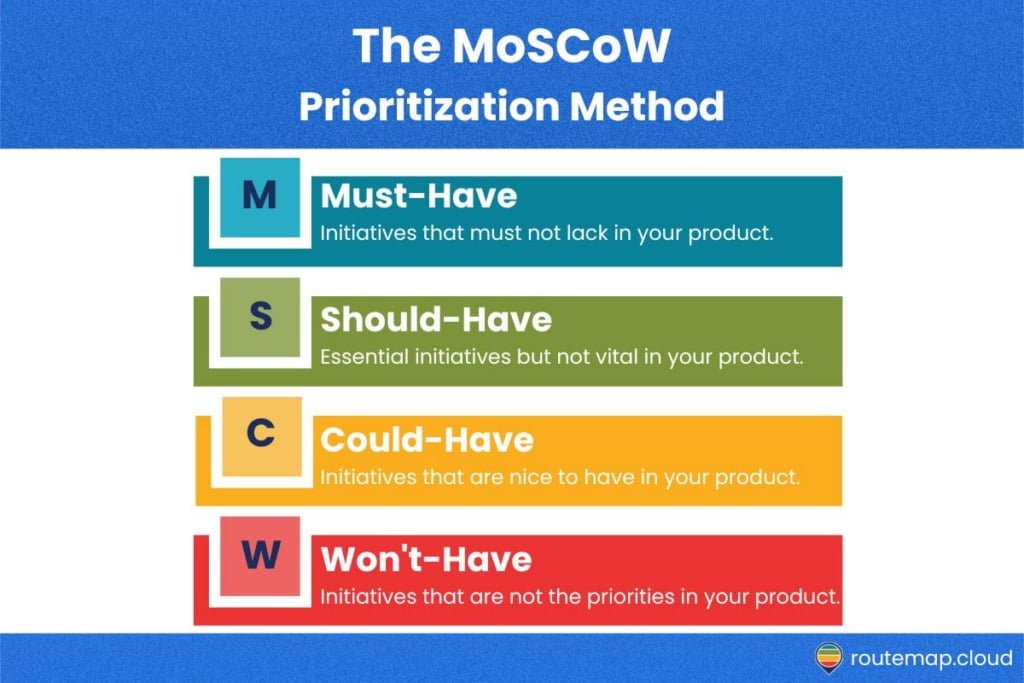Projects, irrespective of their size or complexity, often juggle numerous tasks and requirements. In such a scenario, MoSCoW prioritization becomes essential to ensure the successful completion of the project.
Besides, it is one of the most effective ways to manage project priorities. With a straightforward and adaptable approach, the MoSCoW method helps manage stakeholder expectations and improve project outcomes.
Table of Content
- What is the MoSCoW prioritization technique?
- Why should you use the MoSCoW prioritization method?
- Benefits of using MoSCoW prioritization
- How to implement MoSCoW in your project management
- Case studies of the MoSCoW prioritization
- Mistakes to avoid while using MoSCoW
- Final thoughts on the MoSCoW prioritization
What is the MoSCoW prioritization technique?
The MoSCoW method is a prioritization matrix widely used in project management and software development. The term MoSCoW is an acronym that stands for Must have, Should have, Could have, and Won’t have, each denoting a level of priority.
Here is the breakdown of the MoSCoW method:
- Must have: These are critical requirements that the project cannot do without. If these are not fulfilled, the project is considered a failure.
- Should have: Important but not critical features of a project. These are high-priority items that are not as time-sensitive as the Must-haves.
- Could have: These are desirable features that do not affect the overall project’s success. They can be included if time and resources permit.
- Won’t have: These features are the lowest priority or are not necessary for the current delivery cycle. They are agreed upon and recognized but are dropped for the project’s current timeline.

The method’s roots trace back to the Dynamic Systems Development Method (DSDM), a framework used in agile project management. Its simplicity and effectiveness have made it popular across various industries, helping teams prioritize their tasks more effectively.
Why should you use the MoSCoW prioritization method?
Based on its simplicity and clarity, MoSCoW makes it easy for all stakeholders to understand the project priorities. Besides, this method is also highly adaptable and can be applied across different types of projects and industries.
Moreover, it plays a crucial role in managing stakeholder expectations by clearly defining the project’s needs and wants. It provides a shared understanding of what’s crucial for the project’s success and what can be set aside if needed.
Compared to other prioritization methods, MoSCoW focuses on both inclusion (Must, Should, Could) and exclusion (Won’t). As a result, it offers a distinct advantage in managing stakeholder expectations and scope.
Benefits of using MoSCoW prioritization
1. Provide clear prioritization
This prioritization technique provides a clear and easy-to-understand framework for prioritizing project requirements. By dividing requirements into each value of MoSCoW, teams can easily distinguish between what is necessary, what is important, and what can be postponed or removed from the current iteration or cycle.
2. Simplify the decision-making process
By categorizing tasks based on their importance and urgency, MoSCoW helps in streamlining decision-making processes. As a result, it enables teams to focus on what’s crucial for the project’s success, thereby reducing the time spent on less critical tasks.
3. Enhance communication
The MoSCoW prioritization method enhances communication among project stakeholders. Additionally, it provides a shared vocabulary that all project team members, sponsors, and stakeholders can understand.
Therefore, this shared understanding helps align everyone’s expectations, minimizing potential conflicts or misunderstandings.
4. Improve stakeholder management
This method offers an effective way to manage stakeholder expectations. By identifying and agreeing on the values of MoSCoW, stakeholders have a clear understanding of what to expect from the project.
5. Provide great project flexibility
The MoSCoW method encourages flexibility by allowing requirements to move between categories as the project evolves and new information becomes available. As a result, this makes it particularly useful for agile development methodologies where flexibility and adaptation are key.
6. Allocate resources effectively
By clearly defining the priorities, MoSCoW aids in the effective allocation of resources. Teams can assign resources and schedule time based on the tasks’ priority level, ensuring the most critical tasks are completed first.
7. Offer risk management
MoSCoW prioritization helps mitigate risks by focusing on the completion of “Must have” tasks. These are the most critical to the project, and by ensuring they are completed first, teams can prevent project failure.
How to implement MoSCoW in your project management
With such benefits, you will undoubtedly want to implement this prioritization method in your project.
Here is the step-by-step guide on how to do it:
- Begin by listing all project requirements.
- Initiate discussions with stakeholders to categorize each requirement into the Must Have, Should Have, Could Have, and Won’t Have sections.
- Facilitate negotiations among stakeholders when there is disagreement on the categorization of certain requirements.
- Document the categorization and make it available to all stakeholders.
- Review and adjust priorities throughout the project as necessary.
Case studies of the MoSCoW prioritization
Various organizations have successfully used the MoSCoW method in their projects.
For example, a software development company might categorize the development of a secure login system as a “Must have,” an in-app chat feature as a “Should have,” a language translation feature as a “Could have,” and VR capabilities as a “Won’t have.”
And As you expect. this categorization would help the company prioritize its development process and manage its resources more effectively.
Mistakes to avoid while using MoSCoW
While the MoSCoW method is simple, certain common mistakes can hinder its effectiveness.
For instance, categorizing too many features as “Must have” can lead to confusion and delay. Therefore, it is essential to maintain a realistic and balanced distribution of requirements across the categories.
Another common misunderstanding is the belief that “Won’t have” features are not necessary. These are often features that could bring additional value to the project but are not feasible in the current delivery cycle due to time or resource constraints.
Final thoughts on the MoSCoW prioritization
The MoSCoW prioritization technique provides a straightforward and effective way to manage project requirements. By providing clear categorization, it simplifies decision-making, facilitates communication, and helps manage stakeholder expectations.
Whether you’re in software development, event management, or any industry involving project management, MoSCoW can prove to be a valuable tool.
Don’t forget to stay tuned with Routemap – a great tool for prioritization for Jira – for more updated news and articles.






